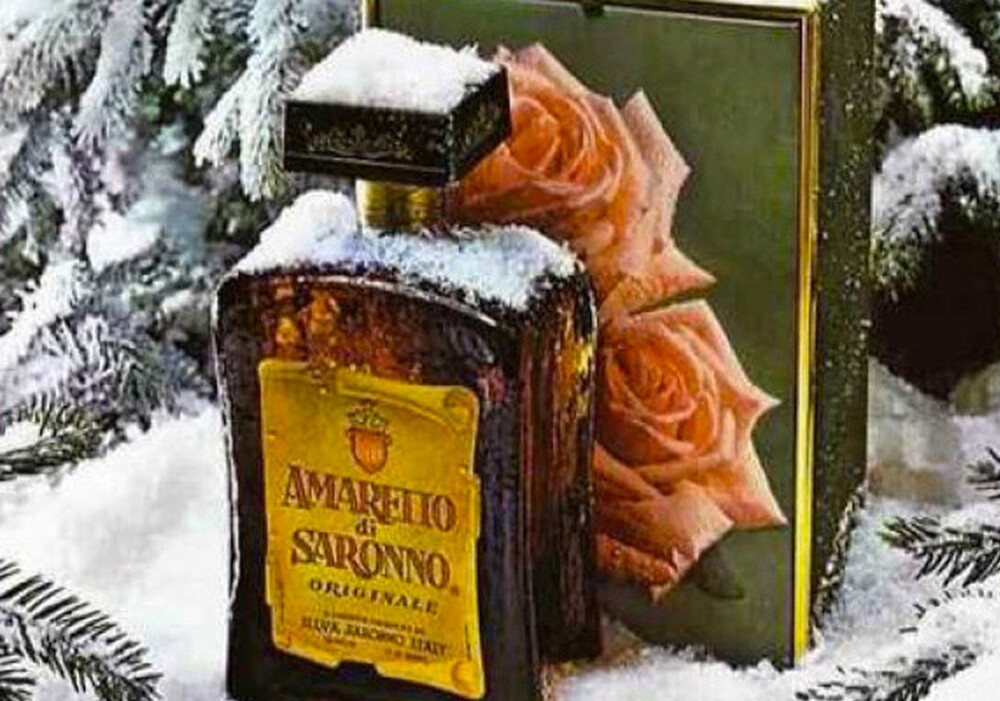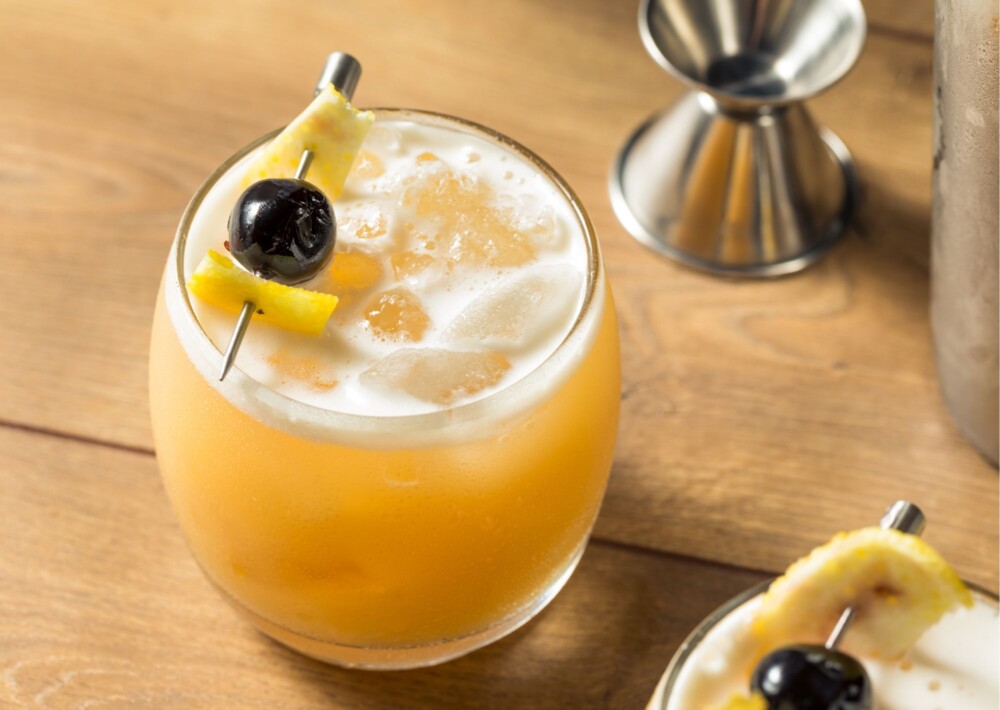The cocktail Amaretto Sour, one of the contemporary classic cocktails, may seem like just another sour made with amaretto. However, both its taste and history are more intriguing than they may appear.
Firstly, what is Amaretto? It is an Italian liqueur whose primary ingredient is almonds. However, some types of amaretto are also made from apricot or peach kernels, which contain a chemical compound called benzaldehyde, giving the drink its characteristic bitter taste and almond aroma. Amaretto is an Italian word meaning “slightly bitter” and is a diminutive form of amaro, which translates to “bitter.” It is essential to distinguish amaretto from other bitter liqueurs, such as amaro, which also contain bitter herbs. Amaretto is a distinct flavor category, with some variations being sweeter depending on the type of almonds used in its production.
The most popular amaretto, which is not amaretto, is the 500-year-old story of Disaronno Originale.
It is said that the amaretto originated from the town of Saronno in Italy, located north of Turin and Verona. One legend states that in 1522, frescoes were being painted in a church in Saronno. The artist Bernardino Luini, responsible for their execution, was one of Leonardo da Vinci’s students. He needed a model to paint the Madonna and chose a young widow who ran an inn. She was so grateful for this honor that she presented him with almonds soaked in brandy as a gift. And thus, amaretto was born. Sounds intriguing, doesn’t it? Other versions mention herbs and fruits soaked in apricot kernel oil or different combinations. In every variation of this legend, the key flavor notes (almonds and/or fruit kernels, as well as alcohol) for amaretto are present. The brand Amaretto Adriatico even mentions almond cookies (amaretti) soaked in alcohol, they make their amaretto with roasted almonds.

Since then, amaretto liqueur has been produced and sold in the town of Saronno, with the greatest commercial success achieved by Disaronno Originale, previously known as Amaretto di Saronno. So, what’s the difference? Well, the most popular amaretto could only register its name as a trademark in the form of DISARONNO®, without the addition of amaretto. The name ‘amaretto’ disappeared from Disaronno bottles during the rebranding in 2001, but the recipe remained unchanged. Disaronno also does not use almonds in its recipe and relies solely on fruit kernels to achieve its unique flavor. For some brands producing this liqueur (like Amaretto Adriatico), almonds are a critical ingredient in terms of taste and tradition, while for others, they are just one of many components. Amaretto is not currently protected by the DOC (Denominazione di origine controllata) or European Union regulations (CE N.110/2008, n.33) like other traditional local spirits, hence there is no single recipe defining this type of liqueur.

Therefore, when searching for the perfect amaretto, it’s worth exploring not only Disaronno Originale but also other classic Italian brands such as Lazzaroni (also from Saronno), Adriatico, or Salizà.
From Italy to….Portland?
Jeffrey Morgenthaler, an American importer from Portland and a partner of Disaronno, played a crucial role in introducing amaretto to the American market. In 1974, he created the recipe for the amaretto sour, a refreshing cocktail that garnered immense interest in the American bar scene. Morgenthaler knew that combining the sweet, almond flavor of amaretto with tart lemon juice and a touch of sweet simple syrup would be an absolute hit. And it was! The amaretto sour not only became a popular cocktail but also contributed to the growth of awareness and interest in amaretto in the United States. Just a few years after its invention, the cocktail found its place in the most important books on the art of bartending.
Textbook Amaretto Sour
 Ingredients:
Ingredients:
- 40 ml amaretto
- 20 ml lemon juice
- ½ egg white
- Ice cubes
- Lemon peel for garnish and a Maraschino cherry
Note: We recommend using approximately 30 ml of lemon juice and 5-10 ml of simple syrup to achieve a well-balanced cocktail.
Preparation:
- In a shaker, add amaretto, lemon juice, simple syrup, and egg white.
- Add a few ice cubes.
- Shake vigorously for about 10-15 seconds to combine all the ingredients and chill the cocktail.
- Pour the contents of the shaker into a glass filled with ice.
- Twist the lemon peel to release its oils, then garnish the cocktail by placing the peel on top.
And now, the recipe for Jeffrey Morgenthaler’s Amaretto Sour (updated version from 2012).
This version is pure magic. Bourbon doesn’t overpower the amaretto flavor but enhances it, allowing the liqueur to shine alongside the tangy citrus notes. His Amaretto Sour is frothy, sweet, tart, nutty, and potent, and the modifications he introduces to the recipe make the cocktail more balanced.
Ingredients:
- 45 ml amaretto
- 30 ml bourbon
- 25 ml lemon juice
- 5 ml brown sugar syrup (or Demerara/Muscovado syrup)
- ½ egg white
- Ice cubes
- Lemon peel for garnish
- Maraschino cherries for garnish
Preparation:
- In a shaker, add amaretto, bourbon, lemon juice, brown sugar syrup, and egg white.
- Add a few ice cubes.
- Shake vigorously for about 10-15 seconds to combine all the ingredients and chill the cocktail.
- Pour the contents of the shaker into a glass filled with ice.
- Twist the lemon peel to release its oils, then garnish the cocktail by placing the peel on top. Optionally add a Maraschino cherry.
And voilà! Delicious Amaretto Sour ready to be served. What sets Amaretto Sour apart from other sours? This cocktail is a true delight for the taste buds. The sweet almond flavor of amaretto intertwines with the tangy citrus accent, creating a unique combination. It’s the perfect choice for those who love sweet drinks, but in moderation.
Have you tried Amaretto Sour yet? If not, we highly recommend it! It’s the ideal drink for people who enjoy sweet flavors, but like their cocktails with a balanced sweetness, just like a well-made cake. Cheers!